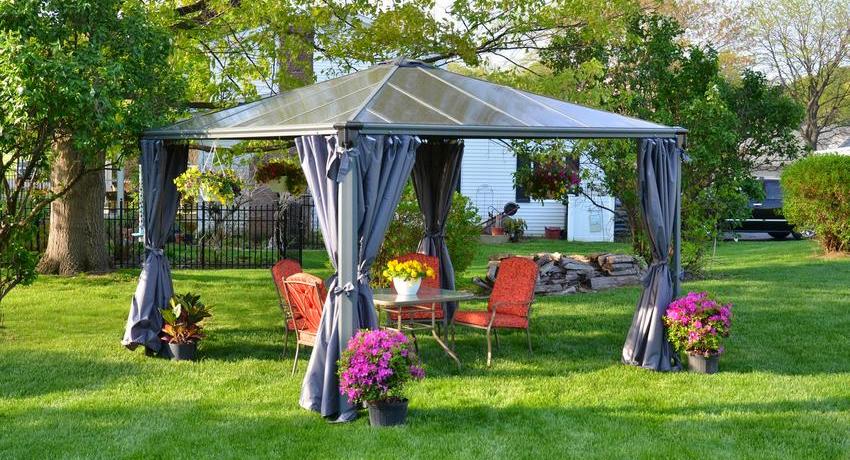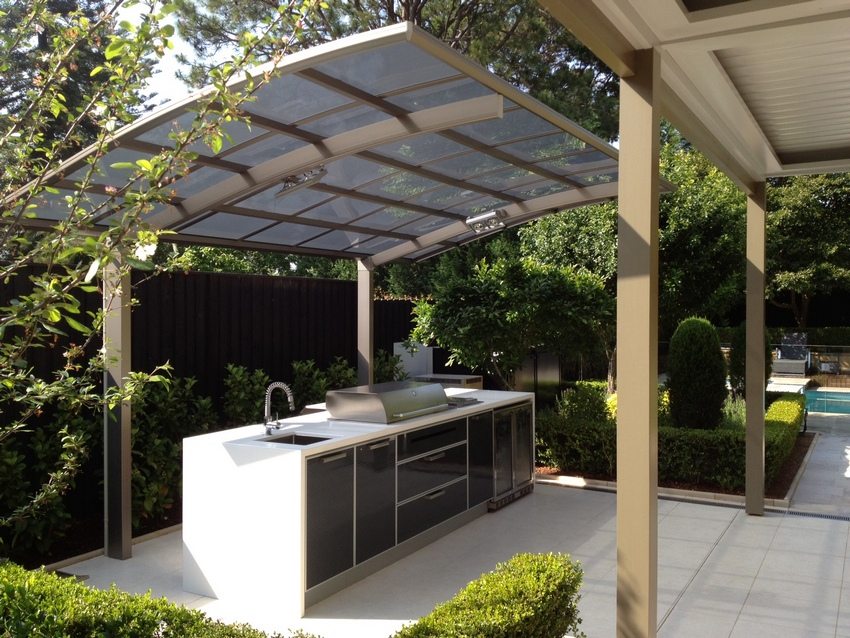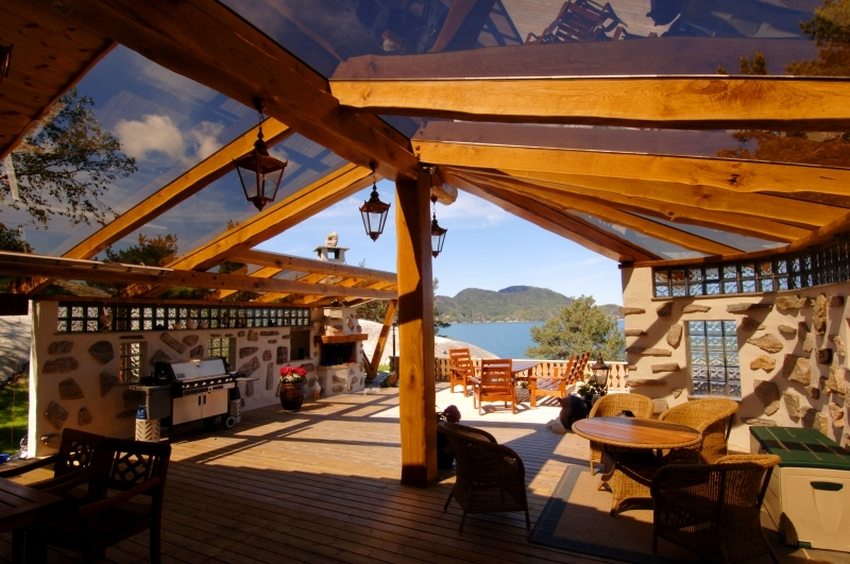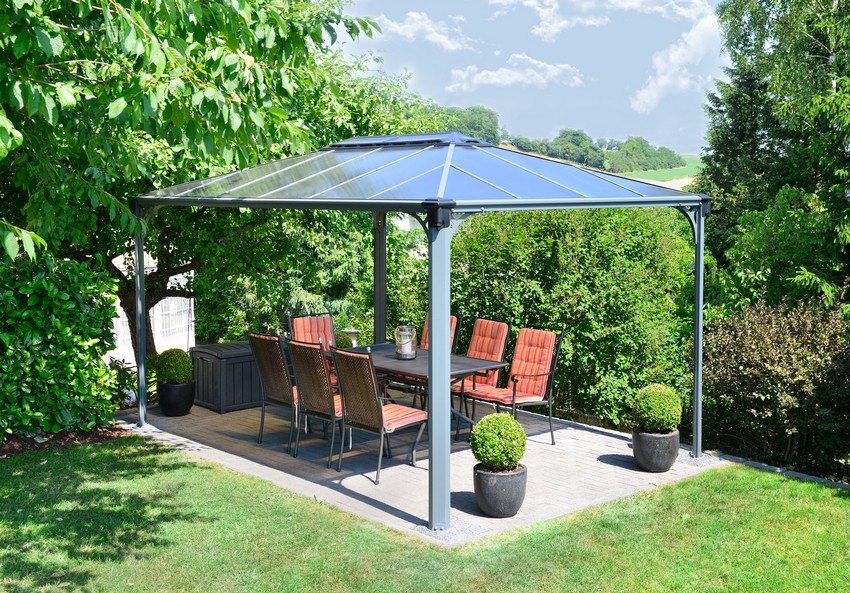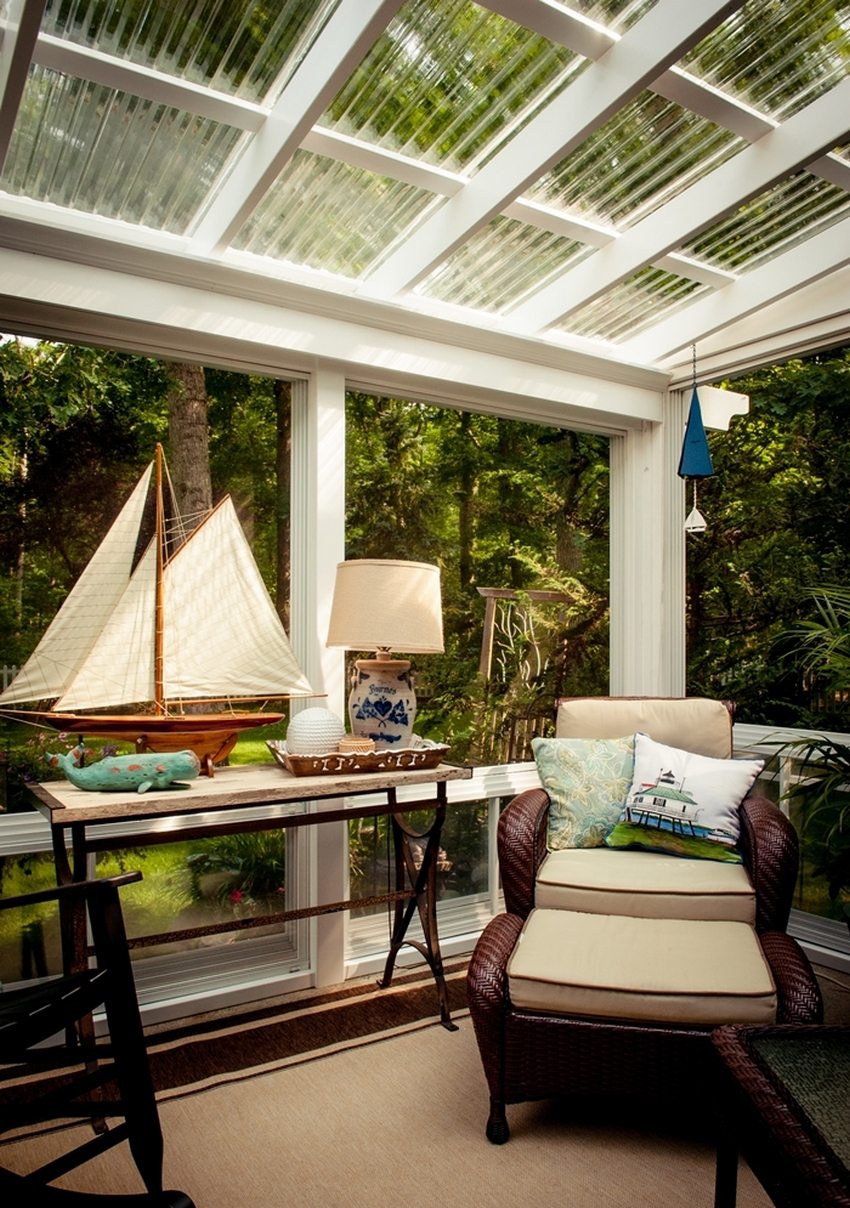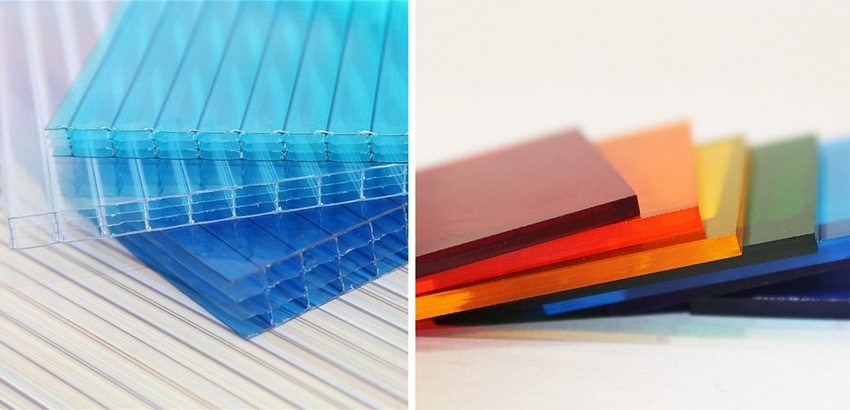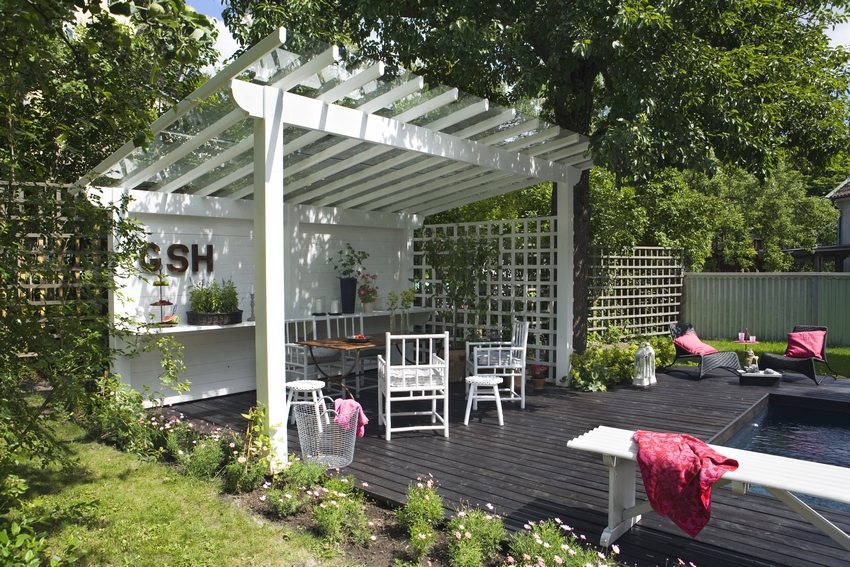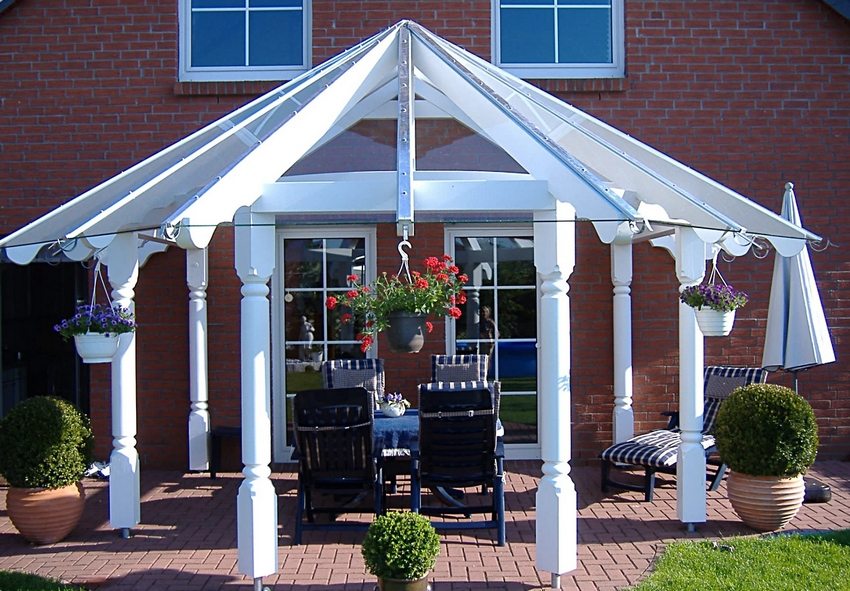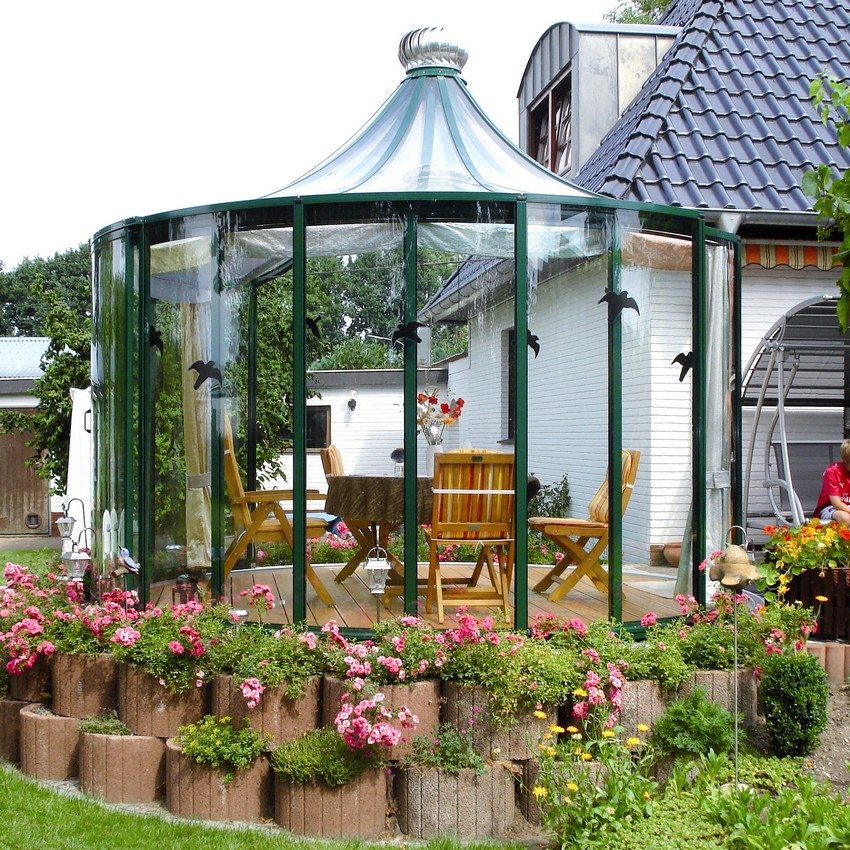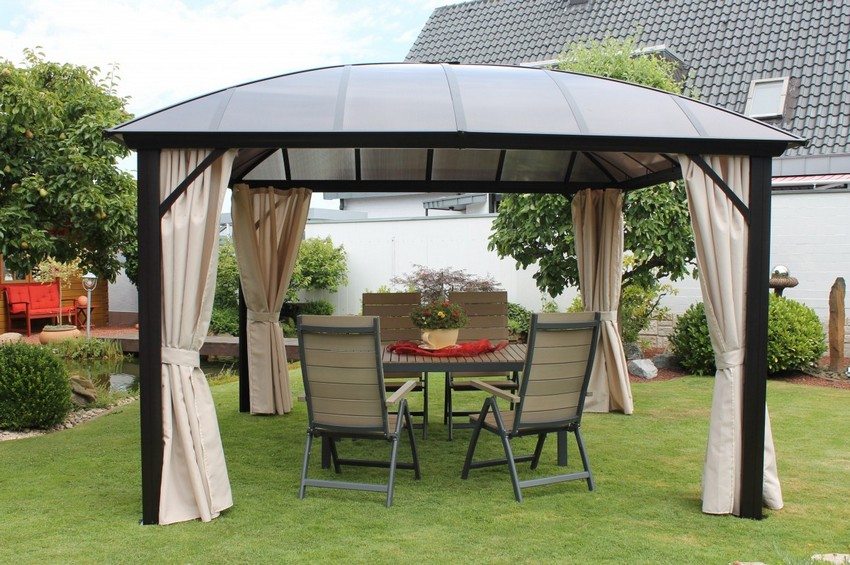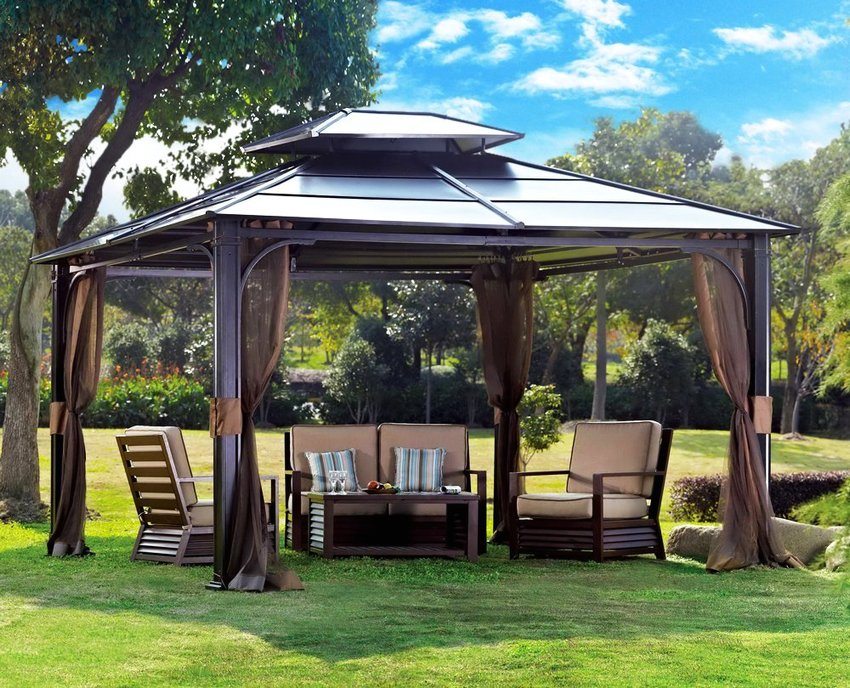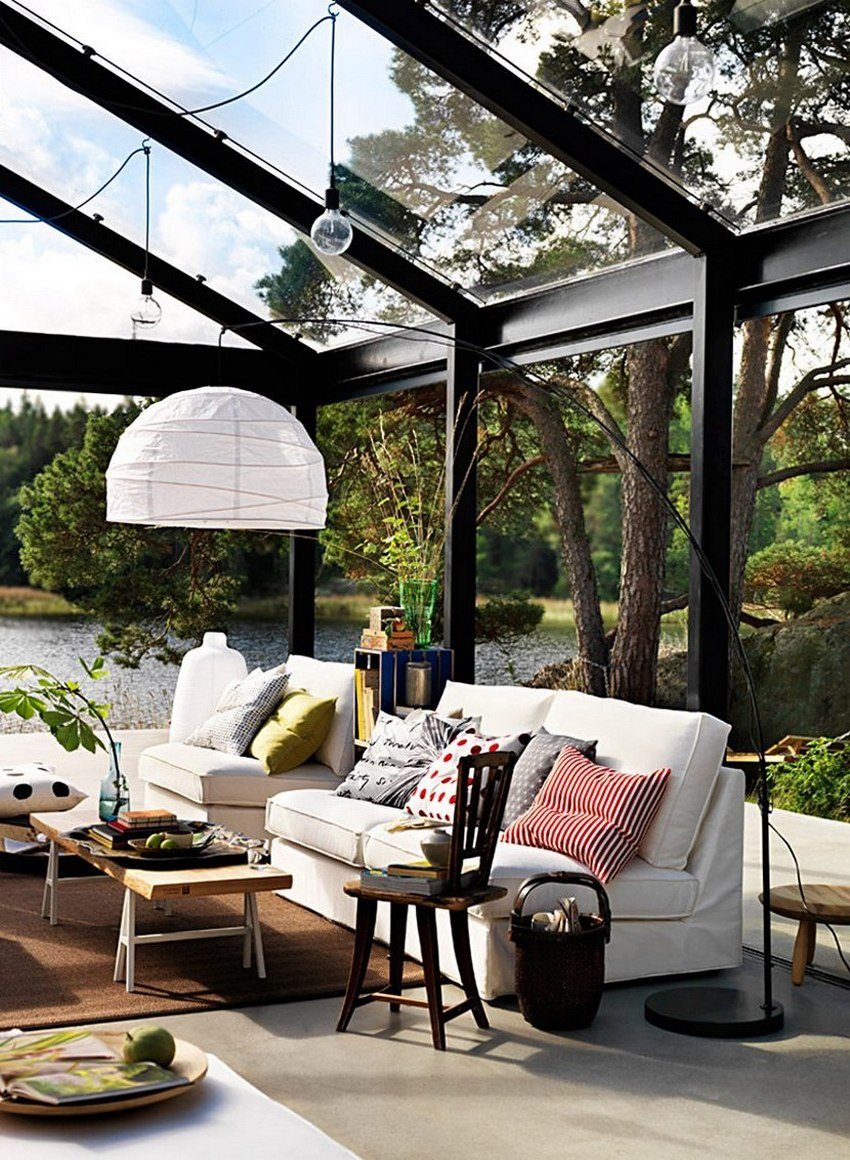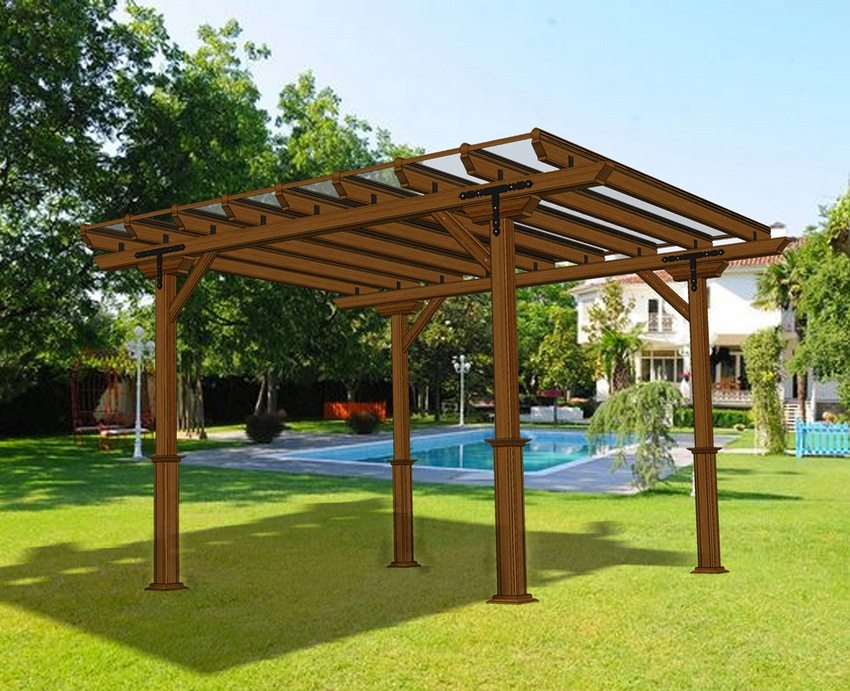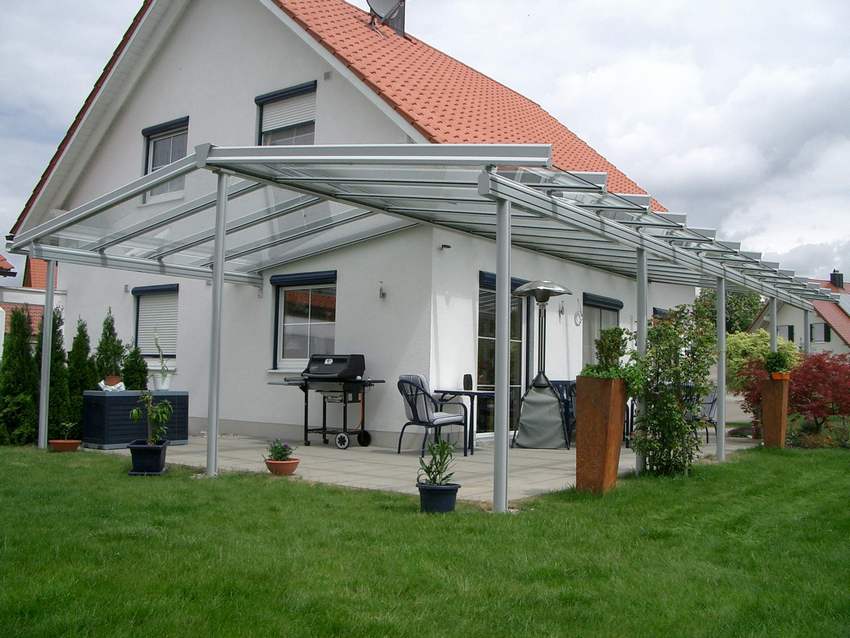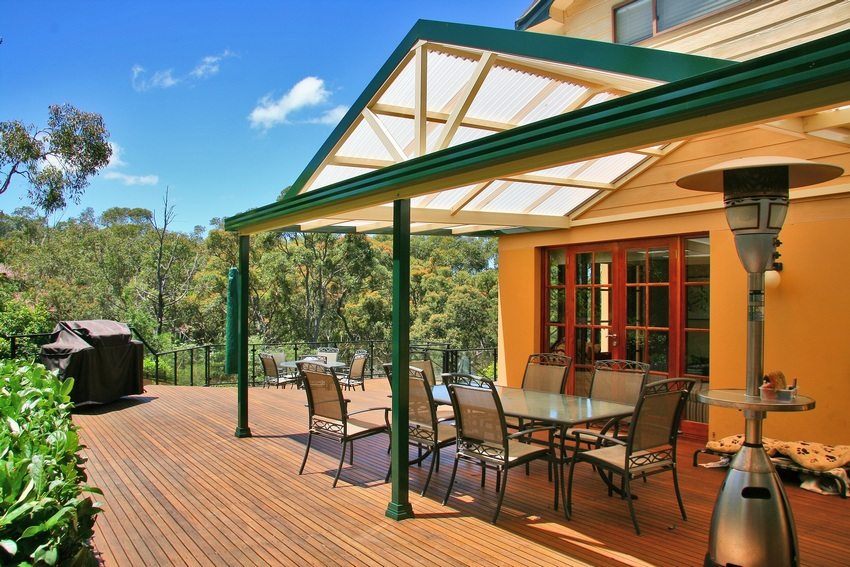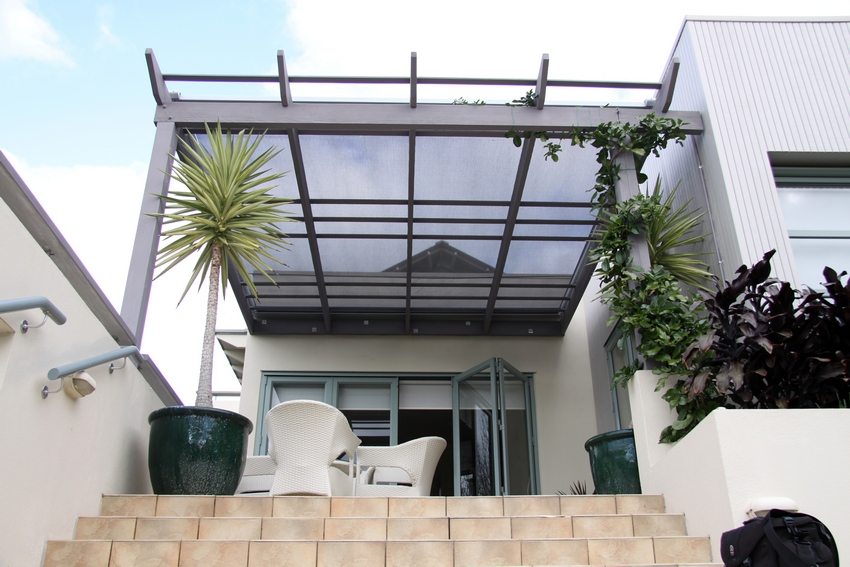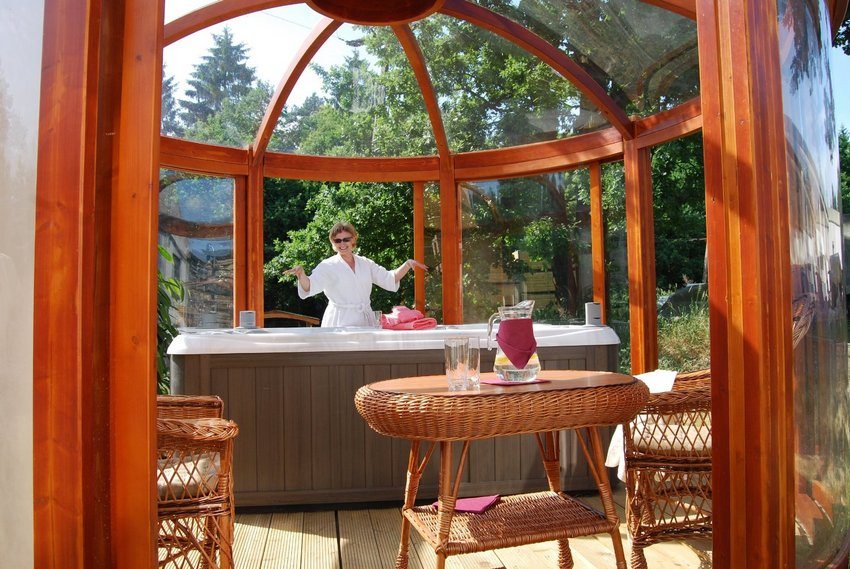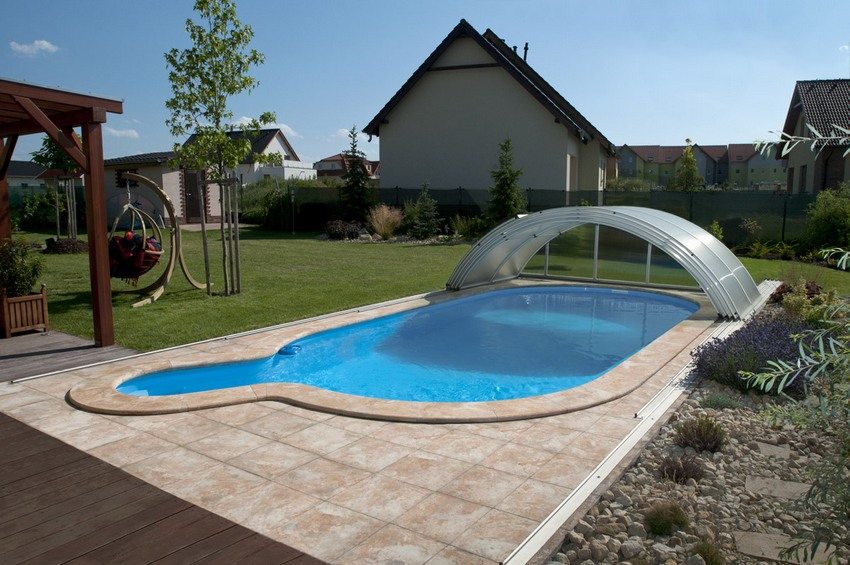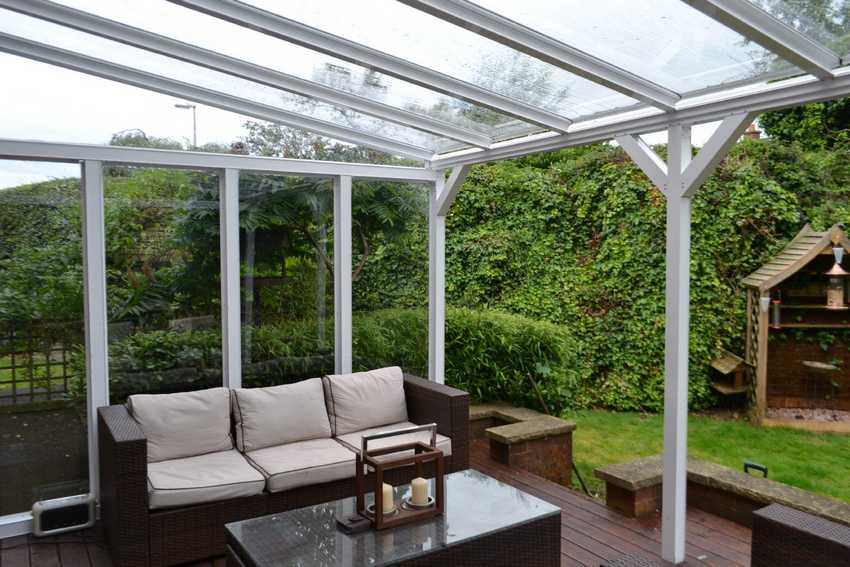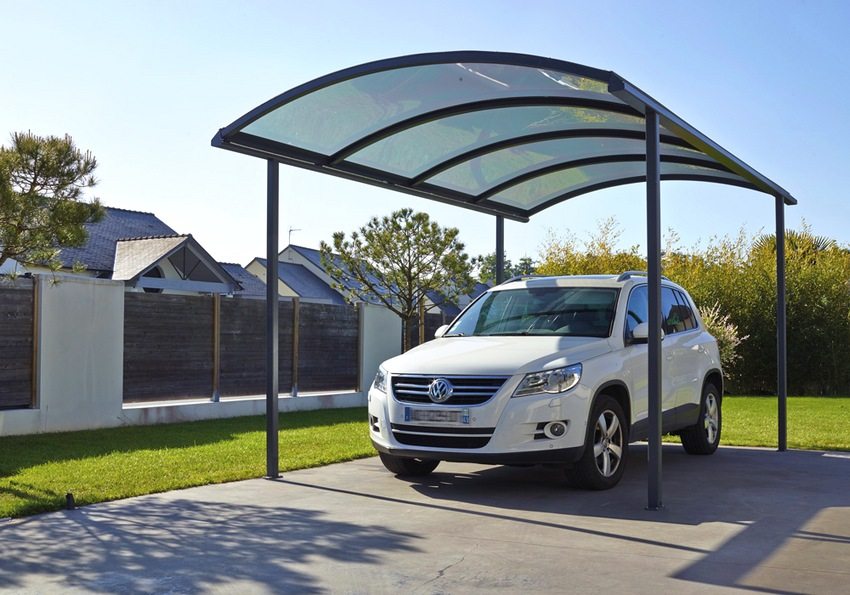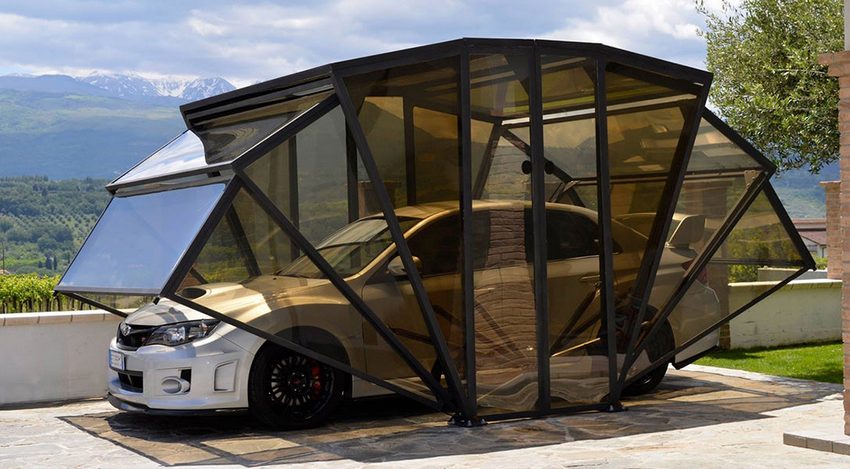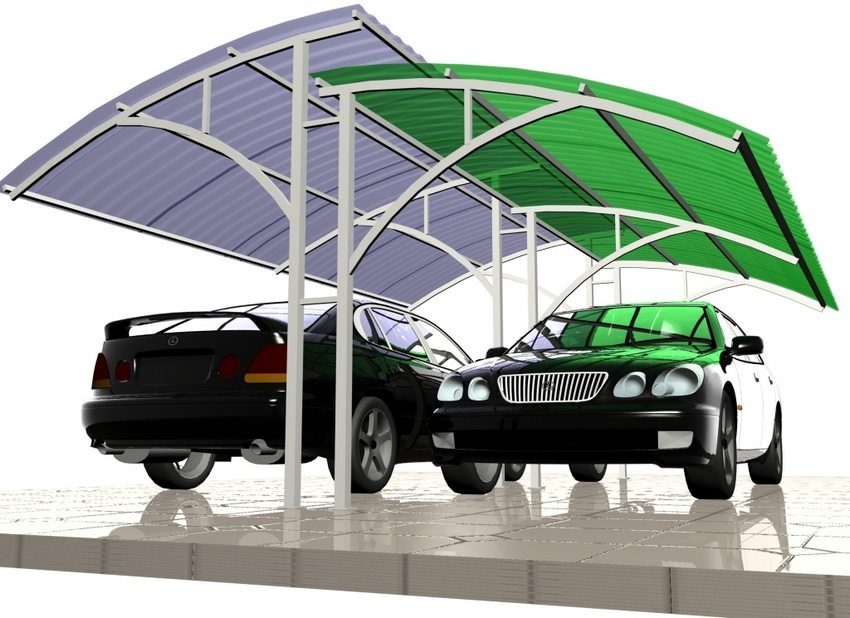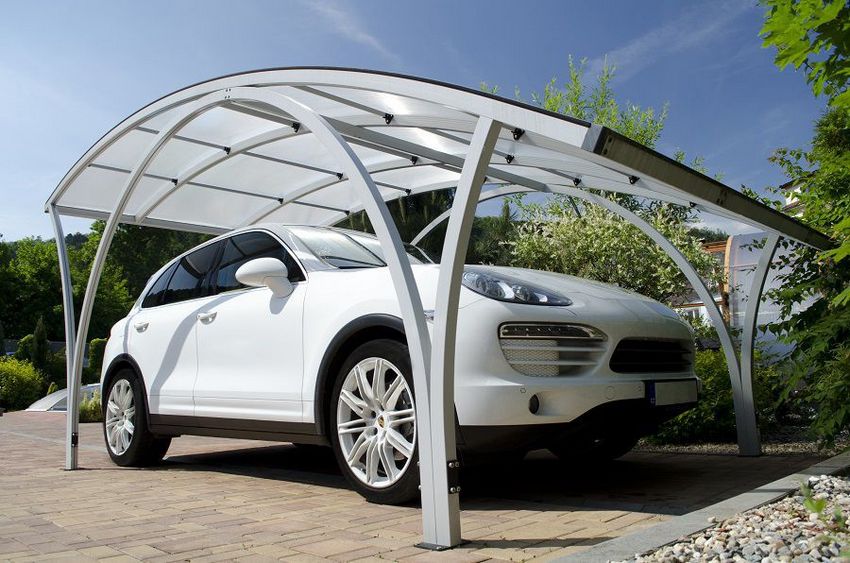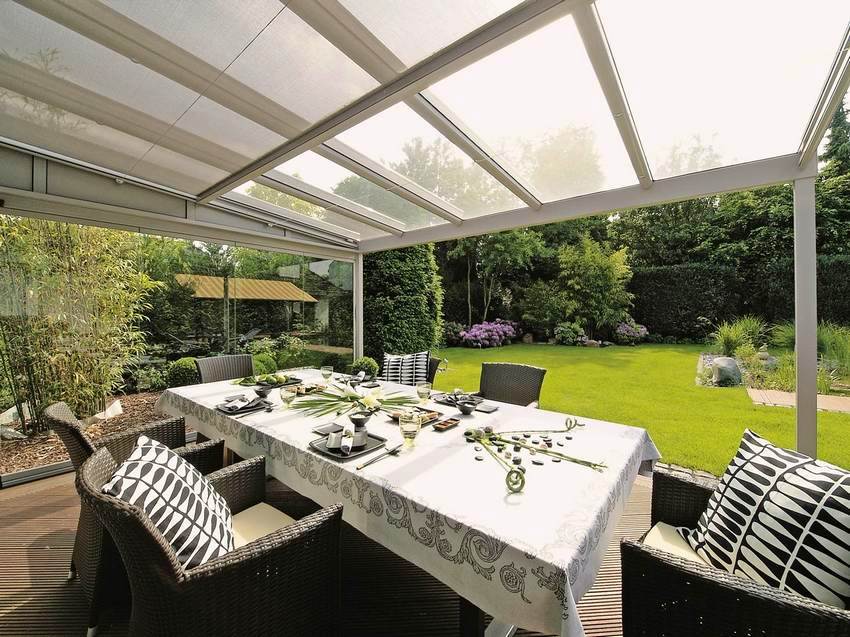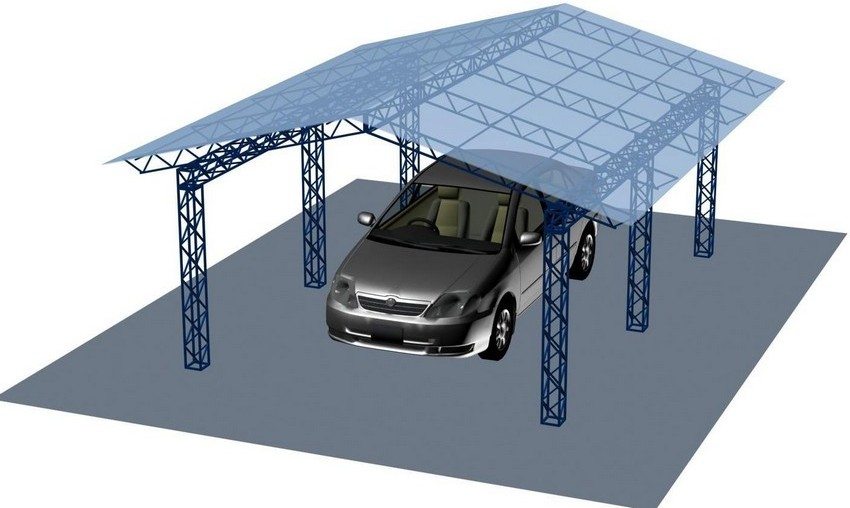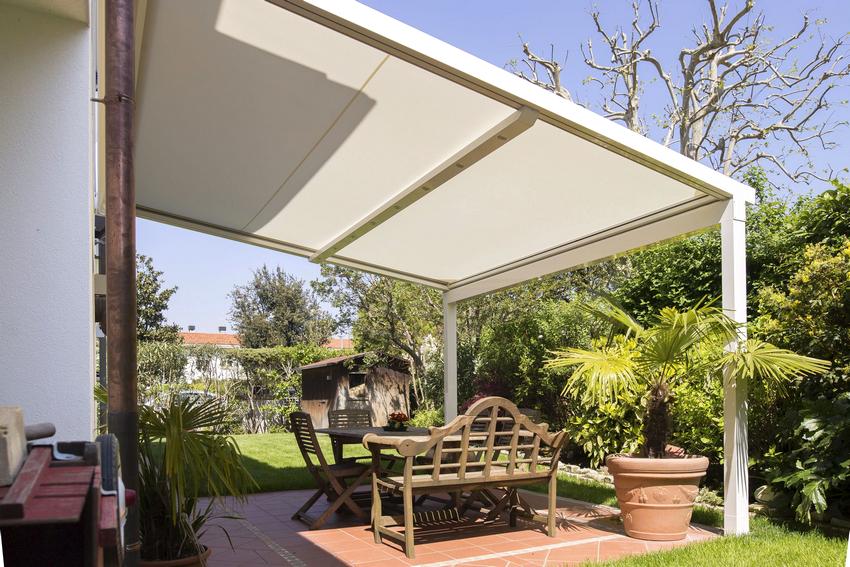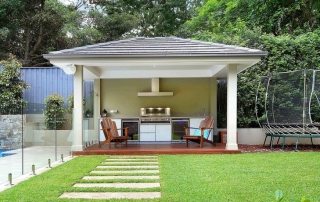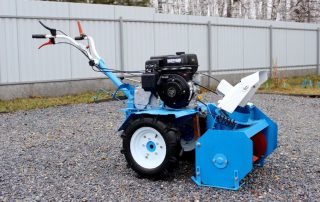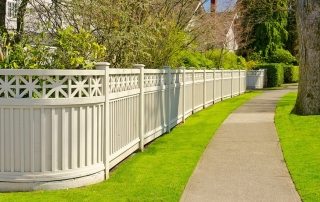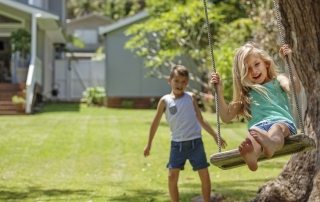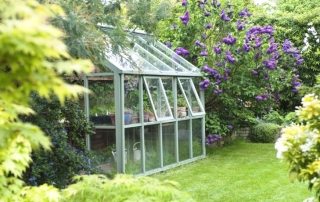Many of us still remember when the awnings were a gray slate structure supported by metal or wooden posts. They, of course, protected from bad weather, but made the space under them dark and dull. Nondescript buildings were replaced by light translucent polycarbonate canopies in the courtyard of a private house: a photo of non-trivial forms reliably demonstrates the grace and functionality of modern canopies made of strong and durable polycarbonate.
Content [Hide]
- 1 The versatility of using polycarbonate awnings in the yard
- 2 Polycarbonate awnings in the courtyard of a private house: photo examples, installation rules
- 3 Forms of polycarbonate canopies and their advantages
- 4 Polycarbonate canopy structures in the courtyard of a private house
- 5 Carports made of polycarbonate. Photos of the best options
- 6 Prices for polycarbonate canopies in the courtyard of a private house. Photos of finished products
The versatility of using polycarbonate awnings in the yard
The appearance on the market of building materials of polycarbonate, which has high optical and mechanical properties, made it possible to successfully use it for various kinds of light structures: light-transmitting roofs, greenhouses, sheds, gazebos, verandas, canopies, summer showers and many others.
Thanks to the plasticity of this material, it has become possible to translate into reality elegant design structures from polycarbonate sheets. The versatility of awnings with the use of polycarbonate lies in the fact that in addition to the function of protection against the negative influence of climatic conditions, they perfectly complement and complete the architectural composition.
The use of polycarbonate sheets for covering canopies is explained by a number of quality characteristics of this material:
- high impact strength - with a low weight, polycarbonate is hundreds of times stronger than glass and many times stronger than acrylic plastic and polyvinyl chloride;
- light weight - provides ease of cutting, processing and installation;
- heat resistance - withstands temperature drops from -30 to + 55 ° С;
- does not require additional processing, easy to clean;
- excellent design characteristics - it has plasticity, bends easily, has a variety of colors, manufacturers are constantly expanding the color range.
Useful advice! When purchasing polycarbonate for awnings, try to choose a color that will create a comfortable shade of light under the building. Green is suitable for a recreation area, bronze for a car, and turquoise above the pool will give the water a natural shade.
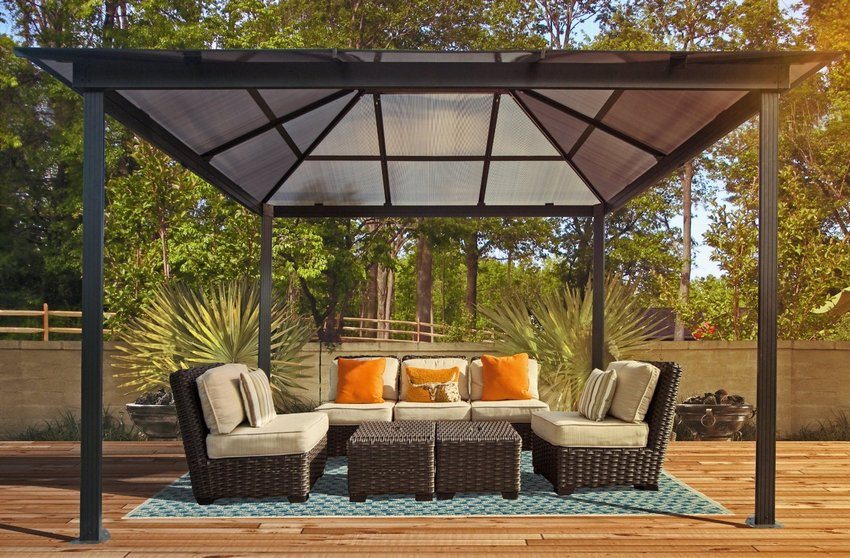
Due to the plasticity of the material, polycarbonate canopies can be of the most varied and original shapes.
By its structure, polycarbonate can be monolithic and cellular (honeycomb), having several layers connected by stiffening ribs. Giving preference to using one or another type of plastic to cover the canopy, one should take into account the requirements for the structure. Monolithic polycarbonate - heavy-duty, shock-resistant, durable, but heavier and more expensive. Honeycomb samples are quite plastic, light, due to light scattering, prevent heating of objects under the sheds.
Polycarbonate awnings in the courtyard of a private house: photo examples, installation rules
Given the plasticity and ease of processing of polycarbonate, the fastening of sheets to the frame of the awnings can be done independently. Plastic is well cut and drilled without chipping or cracking. But it is worth familiarizing yourself with some of the rules and nuances of installation:
- it is necessary to lay the sheets with the marked side up, where the plastic is processed with a protective colored film, otherwise the polycarbonate will quickly collapse. Traditionally, manufacturing companies put their logo on this film;

Pergola with wooden frame, covered with polycarbonate sheets
- when drilling holes for fasteners, you need to ensure that the distance from the edge of the sheet is over 45 mm;
- the location of the lines of the edges of the sheets along the length should fall on the longitudinal elements of the frame;
- it is necessary to calculate the exact pitch of the longitudinal supports and transverse elements of the frame to ensure the rigidity of the structure made of polycarbonate panels;
- for point fastening of sheets to the frame, self-tapping screws with special thermal washers (to match the color of the plastic) are used, and the holes for the screws are made a little more, taking into account the thermal expansion of the material;
- the sheets are positioned in such a way as to ensure the removal of condensate from the channels to the outside. The channels in the material have a longitudinal direction;
- if the canopy is arched, the sheet is positioned so that the stiffeners go along an arc, with a pitched canopy - along the slope;
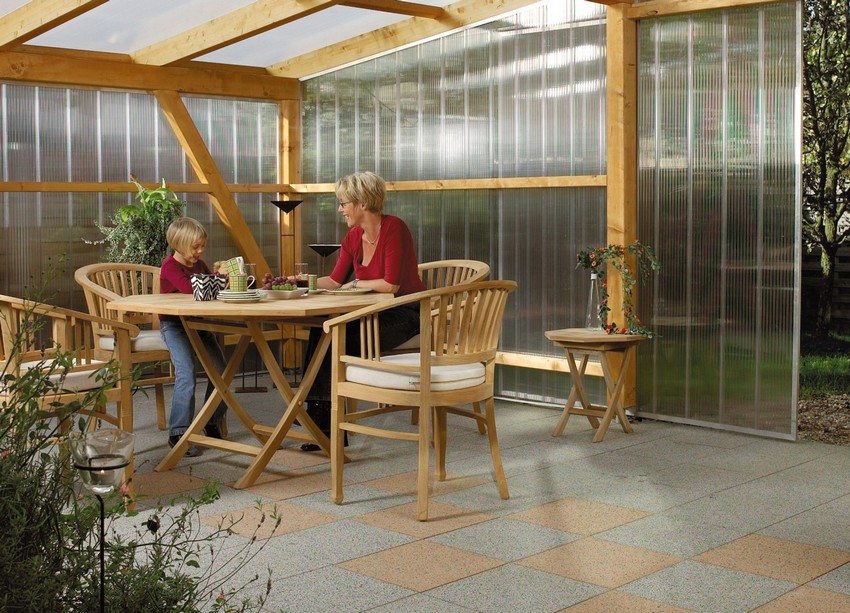
Polycarbonate canopy will reliably protect from both the bright sun and rain
- for longitudinal connection of panels, polycarbonate profiles (transparent or colored) are used;
- the end edges of the sheets must be correctly processed: if the polycarbonate is inclined, the upper edge is closed with a sealed tape, the lower one with punched tape. In an arched structure, both ends are supplied with punched tape. This treatment prevents dust from entering the sheet and at the same time ensures the drainage of condensate;
- when caring for the material, it is not recommended to use abrasive products or remove dirt with sharp objects (knives, screwdrivers).
Useful advice! It is forbidden to leave the end edges of the polycarbonate completely open or completely seal the lower ends. Incorrect processing of the ends of the sheet will lead to a deterioration in the light transmission qualities of the material.
Polycarbonate awnings in the courtyard of a private house (the photo illustrates designs with original lines) fit perfectly into the overall design of the exterior and provide mitigation of the negative effects of bad weather and UV rays.
Forms of polycarbonate canopies and their advantages
Polycarbonate awnings in the courtyard of a private house (photos of structures with different outlines confirm this) can be given any configuration. But there are several types of frames, most often used in the courtyards of their own houses and in summer cottages.
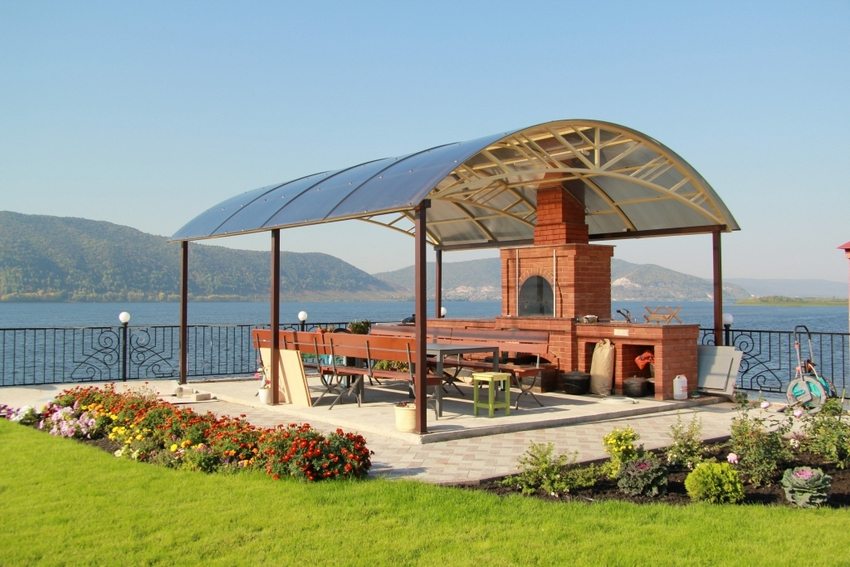
A canopy in the courtyard of a private house can become a favorite place to spend time with your family.
One of the first on this list are arched (semicircular) awnings. They are used to cover the yard, parking space, pool, terrace, balcony, porch. Arched canopies are often used with the support of one side on an existing capital structure or fence. The advantage of this type of frame is, first of all, the free flow of snow from the curtain surface.
Please note that when it rains, water flows down to both sides of the canopy. The arched structure is quite strong and damage to such a structure from strong gusts of wind is unlikely. The difficulty of self-production in the arched version is the complexity of bending the profile pipe of the frame.
Cascading canopy systems look very stylish. They consist of several semicircular structures located at different levels. Such awnings are used to cover a high porch with a large number of steps in order to avoid rainfall on the lowermost step.
If, when protecting the porch, you use only one arched canopy, it will have to be positioned under an appropriate slope, which will allow water to drain directly under the lower step. And the cascade design will direct the water flows to the sides. The manufacture and installation of such a system is more complicated and is associated with additional expenditure of materials.
Shed shed structures are quite simple, but no less popular in the arrangement of the yard. The frame is easy to assemble. There is no need to use trusses to strengthen the structure, bend polycarbonate panels to cover. The main condition will be the correct choice of the angle of inclination and thickness of the coating, at which it will withstand the snow load.
A gable canopy is often used to protect barbecues, barbecues, porches. Its construction is a little more complicated in comparison with the single-slope design, but it is more resistant to powerful wind currents. The gable design itself provides better protection from rain and snow. The steeper slope of the slopes ensures faster snow removal from the roof surface.
Polycarbonate canopy structures in the courtyard of a private house
Many people prefer to attach a canopy to one of the walls of the house. Typically, such structures cover a fairly significant, if not all, part of the yard, which allows you to be outside in any weather. There are awnings covering the passage to summer kitchen or garage, which also relieves discomfort when moving in inclement weather. Suspended structures attached to the house can have a lean-to or arched shape. The main thing is to correctly calculate the load in the winter period of operation of the canopy.
Other popular types of awnings are canopies. Usually they are equipped above the entrance or porch, protecting it from rain and icing during the winter season. Porch canopy will protect against water ingress on the steps and prevent their destruction.You can equip the entrance doors to the workshop, sauna, summer kitchen or basement with a visor.
The shape of the visors is different: single-pitch, gable, semicircular. Care should be taken to ensure that the structure is consistent with the general style and securely fastened. The arched visors with decorations from forged elements look perfect.
Sheds that cover recreation areas, playgrounds, and also act as gazebos are distinguished by their functionality and aesthetics. The variety of designs and colors of these structures is truly impressive. There are products in the form of a dome or a tent, using a combination of polycarbonate colors for various sectors of the coating. Small polycarbonate hinged structures above a complex of several shops and a table where you can enjoy the local landscape, regardless of the weather.
Many pool owners build canopies over them. This greatly simplifies the care of an artificial reservoir and allows you to indulge in water procedures in any weather. Thanks to the protective properties of polycarbonate, you can swim in the pool under such a canopy even when the sun is at its zenith: it will not harm your health.
The design protects the reservoir from debris, foliage and rainwater. Awnings can be installed both permanently and have a collapsible design. For the coating, monolithic polycarbonate with a thickness of more than 5 mm or cellular polycarbonate is often used if its thickness is at least 8 mm.
Polycarbonate awnings covering a balcony or terrace combine functionality and aesthetics. Translucent structures reliably protect open spaces from precipitation, preventing premature destruction. Elegant forms decorate the facade with dignity.
Carports made of polycarbonate. Photos of the best options
Carports that provide car protection are very popular. They are a worthy alternative to capital garages. Such structures can have various shapes, be attached to the house or directly to the garage, and also be installed separately. Some models of canopies have a single-slope shape with a closed back side or are tied to fence plot.
The dimensions of carports are determined based on the dimensions of the vehicle itself. For small cars, it is enough to cover an area of 2.5x5 m, for impressive SUVs or family minivans, the size of the area is increased to 3.5x6.5 m.The height of the canopies is also selected individually, but it is not recommended to make the structure too high, this will contribute to the ingress of some precipitation under covered space.
Especially relevant is the installation of carports made of polycarbonate (photo examples can be used for a sample) in a summer cottage, where there is not always enough space for a garage. In order to save a plot of land, structures are attached to the house, and if necessary, they build free-standing canopies.
Considering certain characteristics of polycarbonate, such a coating is the best suited for protecting the car. You can be sure that the car will be protected from precipitation and will not overheat in the sun. By choosing a material of one color or another, you can adjust the illumination of the space under the canopy.
Many craftsmen install polycarbonate carports on their own. The price in this case will include only the cost of materials.
Prices for polycarbonate canopies in the courtyard of a private house. Photos of finished products
The construction of conventional polycarbonate awnings is quite simple and consists of support posts, frame and cover. Such structures are easily erected on their own. But the manufacture of more complex canopies made of polycarbonate (photos and prices are indicated in catalogs) are best left to experienced craftsmen.
Given the increasing demand for awning designs, many manufacturers offer their services for their manufacture and installation. You can purchase accessories for the canopy from manufacturers, or order ready-made products with installation. Prices for finished products with polycarbonate coating are quite loyal.
Related article:
Do-it-yourself polycarbonate canopies for a private house: a photo of modern hinged structures. Types and drawings of awnings. Types of polycarbonate for canopies. Installation of a polycarbonate canopy.
The full package includes the following services:
- departure of a representative to the site and taking measurements;
- fabrication of a structure at the manufacturer's premises;
- delivery to the place of installation and installation of the canopy.
When ordering a particular model of a canopy, you can choose the size, shape of the structure, materials for making the frame, as well as the color and thickness of the polycarbonate coating. Individual adjustments can be made to the project at your request. Installation time is from one to three days and depends on the conditions and complexity of the assembly.
On the manufacturers' websites, you can find various models of polycarbonate carports (photos and product prices are indicated in the relevant sections). The cost of a set of products with dimensions 4300/3800/2500 mm (length / width / height) is 55,300 rubles, a more overall structure with dimensions of 1600/3800/3100 mm will cost 207,240 rubles. All finished products are accompanied by a guarantee. If the dimensions of the canopy you need are not included in the manufacturer's price list, you can use a calculator to calculate the cost of the product.
Companies specializing in the manufacture of awnings carry out projects taking into account the wishes of the client, the design of the buildings in the yard and the landscape. After completing the necessary calculations, the customer is provided with a full estimate for the company's services. The table shows the approximate prices per square meter of polycarbonate canopy structure:
| Construction area, m2 | from 15 up to 25 |
from 25 up to 30 |
from 30 up to 60 |
from 60 up to 80 |
from 80 up to 180 |
| Price for 1 m², rub. | 4600-4900 | 3900-4450 | 2900-3750 | 2550-3300 | 2350-3400 |
By using the services of professionals in the manufacture and installation of curtain wall structures, you get a reliable, durable and aesthetic canopy that will perfectly fit into the exterior and will last for many years.
